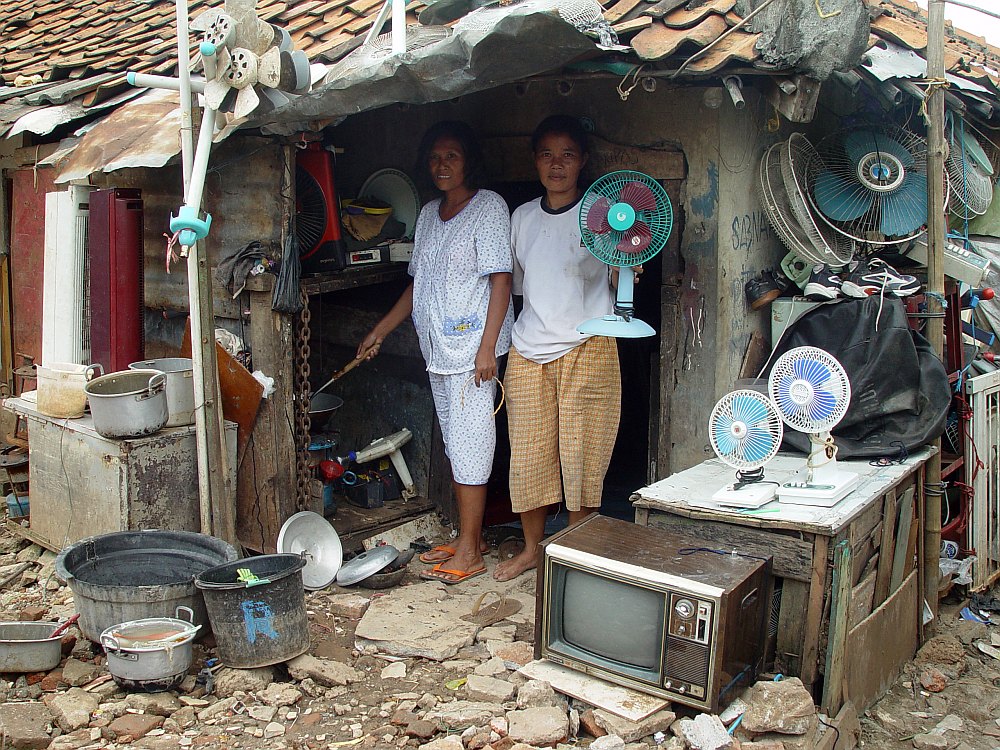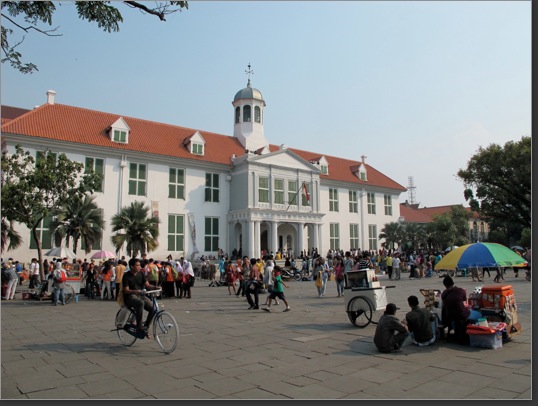To the Capital: Jakarta
As I mentioned in my previous post, I was to take a bus from Bandarlampung, then a ferry from Sumatra to Java, and finally a bus to central Jakarta. What I didn't realize was that the bus actually drove onto the ferry and we never had to get out! When the bus turned the lights on I assumed we were near the ferry terminal, when in fact we were already in Jakarta!
 |
| Here's a map of Java; Sumatra is the island to the northwest and Bali is to the east. We island hopped without me even realizing it - I'm just glad I was able to fall asleep! |
While in Sumatra I had arranged to stay with a local host via Couchsurfing. Well not exactly a local; he is from Singapore but has been working in Jakarta for 2 years. To my surprise (and relief) he answered my text at 5 am and gave me his address. The worker in Lampung told me we would arrive at 9, but I think there was some confusion and she meant the trip would take 9 hours. Luckily I got the apartment address and was off with a moto driver.
At my host's apartment I got a few more hours' shuteye before heading out to explore the city. Jakarta is by far the largest city in Indonesia, and one of the largest in the world. It's metro area is hard to pin down because there are so many towns and sprawl surrounding the city. The official number puts Jakarta's metro at 28 million people! And the surrounding metro area (excluding the city itself) has a population density similar to the city of Chicago and three times the city of Columbus!
 |
| Jakarta has many modern office buildings and apartments. |
 |
| But economic progress has passed over many residents |
Talk about a lot of people in a small space! But Jakarta isn't alone in that regard. The island of Java, with more than 130 million people, is the most populated island in the world. It's smaller than Great Britain but has twice the population; it's even smaller than the south island of New Zealand, with all of its 1 million residents (here is a list of the world's most populous islands).
Thankfully my host's apartment was near the center of the city. Despite its enormous population Jakarta lacks a rapid transit system. Yes, that is correct - no subway or extensive rail network for a metro of 28 million! Instead some 10 million motorcycles, cars, and other vehicles pack the city's streets daily. There are plans for more rail lines or a subway, but nothing has yet moved forward from the planning stage. Check out this NY Times article on the traffic in Jakarta. The example that struck me the most was a man's commute which took 90 minutes for just 9 miles!
 |
| Crazy Jakarta traffic |
Strange as it may seem, I actually wanted to experience the craziness of Jakarta gridlock. I'd been in terrible Manila traffic, and Bangkok could be a pain, but I had heard awesomely horrendous things about Jakarta and wanted to see what all the hubbub was about. Unfortunately, because it was the end of the Ramadan holiday, many Indonesians were still visiting their home towns away from the city and were not yet back to work (wait, why am I upset that I didn't sit in traffic for hours on end?). I only spent three nights in the capital, Friday, Saturday, and Sunday, so the weekend is also a bad time to judge.
Even then the traffic was bad, just not as atrocious as I'd imagined. Thankfully Jakarta has a new bus system (TransJakarta) which I took from near my host's apartment to Kota, known as Old Jakarta. That Friday I explored the small Dutch colonial area in Kota and nearby Chinatown. While I was in Chinatown (an area called Glodok) that afternoon, my host called to say I could only stay with him that night. He said a friend was arriving Saturday morning and needed a place to stay last minute. I later learned that it was actually a friend of a friend; my host said he couldn't turn down her request. Apparently he doesn't understand the difference between "can't" and "don't want to."
 |
| The colonial town hall in Kota |
 |
| Many of the colonial buildings are in poor shape, but the government has been devoting resources to spruce up the area and attract tourists. |
I was salty when I found out my host was kicking me out for a friend of a friend; more so when he offered to try and find me another place to stay and then never mentioned it again. If I didn't use couchsurfing, I thought, I'd be in this situation (having to find a place to stay) anyway, so really it wasn't such a big deal. My host also invited me to go out with his friends Friday night, and I wanted to enjoy it. So I put that snafu aside and had a great time out.
And Friday night was fun; we had dinner, a few drinks at a bar, and finished the night clubbing. Sound strange to go clubbing in a majority Muslim country? I was surprised too. Lonely Planet describes Jakarta as the "clubbing mecca of Southeast Asia," and says "there are underground clubs in Glodok so deep down and dirty that they make the UK's acid house scene of the 1980's seem like a teddy bear's picnic." Apparently we skipped that scene in Glodok, but judging from my limited experience I was impressed with Jakarta's nightlife nonetheless.
 |
| clubbing in Jakarta |
On Saturday morning, wishing I could go back to bed, I left my host's apartment in search of a hotel. The area around Jalan Jaksa (Jalan means street) has many hotels, hostels, and bars catered to tourists. It's nowhere near the size of Khaosan Road - Jakarta sees a fraction of the foreign tourists that Bangkok does - but has all the necessary amenities nonetheless.
After booking a place to stay and a siesta I went exploring. The National Monument (known as Monas), with a huge surrounding park, was within walking distance of my hotel. Apparently the tower offers great views of the surrounding city, but I arrived just as it was closing. As it turned out, the following day (Sunday) was Indonesian Independence Day, and the park was full with visitors, mostly Indonesian. Tents were set up with representatives from every province in Indonesia, wearing traditional dress.
| Monas, built to commemorate Indonesia's struggle for independence |
That evening I went for a drink and karaoke session with a group of locals. On Friday night I met a girl at the club, we exchanged numbers, and she asked if I wanted to hang out with her friends the next day. Karaoke wouldn't be my first choice, but I'd be lying if I said it came as a surprise! Even though I warned them about my awful voice they were still amazed just how terrible it was. But hey, I did log several great scores on the karaoke machine!
On Sunday I again tried, unsuccessfully, to see the Bank Museum. It covers Indonesian history from a financial perspective. I was particularly interested in the 1997 financial crisis and ensuing riots. A note on that before I continue: Jakarta has a significant ethnic Chinese population (over 5%) who constitute a disproportionately large percentage of the wealthy merchant class. As the economy hit the wall during the East Asian financial crisis (more info here) protesters turned to the streets, and when police reacted violently things turned from bad to worse. Much of the anger was directed at Chinese Indonesians; shops were burned, stores looted, and over 1,000 people killed in the chaos. The incidents, paired with Indonesia's poor economic performance, led to President Suharto's resignation.
 |
| The Bank Museum is in a Dutch colonial building; I can't comment on the interior though! |
 |
| Photos from the chaotic and deadly May 1998 riots in Jakarta |
While I was in Kota on Friday I went to the museum, but it closed at 4:30; as it was already 4 I didn't want to try and rush through the whole thing in 30 minutes. I figured I would have time to check it out another day. What I didn't anticipate was that it would be closed on Sunday for Independence Day. I also was planning on visiting the National Museum - would it be closed as well?
Thankfully the National Museum was still open. Located directly across from the National Monument and park, it focuses on Indonesia's archeological history and ethnological make-up, with a large portion devoted to the major ethnic groups within each region of the country. I was impressed with the museum, so much so that I didn't get through it all!
My time at the National Museum was cut short when I was drawn outside by the sound of traditional music. On the main avenue just outside the museum I found a large parade procession. The museum security guard informed me it was the Independence Day parade; I had read about it in my guidebook but wasn't sure where to find it. Luckily it found me! The groups from each province that I had seen at the national monument were now marching on the street with floats, playing traditional music and dancing. Even the two Papua provinces, who have called for independence from Indonesia, made an appearance.
 |
| The National Museum gets my recommendation |
 |
| Thousands turned up to watch the Independence Day parade; these participants are from central Java |
 |
| The flag of West Papua; many Papua natives want autonomy or full independence from Indonesia |
I had considered leaving for my next destination on Sunday, but after watching the parade for 2 hours it seemed best to put off my departure one day. It was already late and I hadn't seen all of the National Museum either.
On Monday I got lunch with part of my karaoke group and then checked out the rest of the museum. It also seemed a good opportunity to see the Bank Museum in Kota that I had already missed twice. Guess what? It was open from Tuesday through Sunday! So zero for three - I guess it just wasn't in the cards. Instead I explored the area east of Monas, which had a few sites including Indonesia's enormous National Mosque and a smaller yet charming Catholic cathedral.
 |
| The National Mosque |
While on my walk I booked an overnight train ticket to Yogyakarta. I ate dinner back near my hotel, picked up my luggage, made my way to Gambir Station, and said goodbye to Jakarta.



Comments